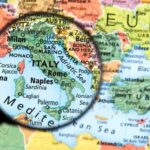What are the travel restrictions for Italy? As the world continues to navigate the challenges posed by the COVID-19 pandemic, it is essential for travelers to stay informed about the current regulations and guidelines in place for visiting different countries.
In this article, we will delve into the specific travel restrictions for Italy, providing a comprehensive overview of entry requirements, quarantine guidelines, regional restrictions, transportation limitations, and more. Understanding these restrictions is crucial for anyone considering travel to Italy in the current context.
Amidst the global pandemic, Italy has implemented various travel restrictions and regulations to mitigate the spread of COVID-19 within its borders. The COVID-19 situation in Italy has had a significant impact on travel, leading to specific entry requirements and quarantine protocols for incoming travelers. It is essential for individuals planning to visit Italy to understand these measures and ensure compliance with all necessary guidelines.
In this article, we will explore the COVID-19 situation in Italy and its implications for travelers. We will also provide detailed information on entry requirements for visiting Italy and any documentation or testing necessary for entry. Additionally, we will discuss quarantine guidelines for travelers arriving in Italy and any regional restrictions or regulations that may be in place within specific areas of the country. Understanding these aspects is vital for anyone considering travel to Italy at this time.
COVID-19 Situation in Italy
Current Status of the Pandemic
Italy, like many countries around the world, has been significantly impacted by the COVID-19 pandemic. As of the latest update, Italy continues to experience fluctuating numbers of cases, with some regions seeing a decrease in infections while others are still struggling to contain the spread of the virus. It is important for travelers to stay informed about the current situation and be prepared for any changes in travel restrictions.
Impact on Travel
The pandemic has had a dramatic effect on travel to and within Italy. Many popular tourist attractions have been closed or have limited access, making it difficult for tourists to fully experience all that Italy has to offer.
Additionally, there have been significant disruptions to transportation services, including reduced schedules for trains and buses, as well as limitations on domestic flights. Visitors should also be aware of the impact on accommodation options and dining establishments, which may have altered operating hours or services available.
What Are the Travel Restrictions for Italy?
Given the current COVID-19 situation in Italy, there are several travel restrictions in place for individuals entering the country. These restrictions may include mandatory quarantine periods, testing requirements, and documentation such as a negative PCR test result or a vaccination certificate. It is crucial for travelers to review and comply with these regulations before planning their trip to Italy. Additionally, visitors should stay updated on any regional restrictions or advisories that may affect their travel plans within the country.
Entry Requirements
As of the current situation, Italy has implemented various travel restrictions in response to the COVID-19 pandemic. For individuals planning to enter the country, it is essential to understand the entry requirements and any necessary documentation or testing that may be required. Travelers must be aware of these protocols to ensure a smooth and hassle-free entry into Italy.
One of the primary entry requirements for travelers entering Italy is the completion of a self-declaration form. This form includes information about the traveler’s contact details, intended place of stay, and confirmation that they are not currently experiencing COVID-19 symptoms.
Additionally, depending on their country of origin and travel history, travelers may also be required to present a negative COVID-19 test result upon arrival in Italy. It is important to note that these requirements may vary based on nationality and recent travel activities.
Furthermore, travelers arriving from certain countries may be subject to quarantine upon entry into Italy. The duration and specific guidelines for quarantine can vary, so it is crucial for travelers to stay updated on the latest regulations. It is recommended to check with Italian authorities or local embassies for the most current information regarding quarantine protocols for incoming travelers.
Quarantine Guidelines
Italy has been implementing various travel restrictions in response to the ongoing COVID-19 pandemic. For individuals planning to visit Italy, it is crucial to understand the quarantine guidelines and protocols that are in place for travelers arriving in the country. These measures are designed to help prevent the spread of the virus and protect the health and safety of both residents and visitors.
As of the latest updates, Italy requires all travelers arriving from certain countries to undergo a period of quarantine upon entry. The duration of the quarantine period may vary depending on the traveler’s origin and specific circumstances. Additionally, travelers may be required to provide proof of a negative COVID-19 test result taken within a specified timeframe before their arrival in Italy.
It is important for travelers to stay informed about the current quarantine guidelines and requirements for entry into Italy. These measures are subject to change based on evolving developments related to the pandemic. By staying updated on these protocols, travelers can ensure compliance with regulations and make necessary preparations for their visit.
| Traveler Origin | Quarantine Duration |
|---|---|
| Countries with high infection rates | 14 days |
| Countries with lower infection rates | 7 days |
Regional Restrictions
Italy, like many countries, has implemented regional travel restrictions and regulations in response to the COVID-19 pandemic. These measures are put in place to control the spread of the virus and protect public health. Travelers planning a trip to Italy should be aware of these regional restrictions in order to have a smooth and safe travel experience.
As of now, Italy is divided into different color-coded zones based on the level of COVID-19 risk: white, yellow, orange, and red. Each zone has its own set of regulations and restrictions that may impact travelers. For example, in red zones, there may be limitations on non-essential travel and strict curfews in place. In yellow zones, some restrictions may still apply, but they are generally less stringent than those in red zones.
Additionally, each region within Italy may have its own specific travel guidelines and requirements. It is important for travelers to stay updated on the latest information from local authorities regarding any restrictions or regulations that may affect their travel plans. This includes checking for any entry requirements or quarantine guidelines that may be unique to certain regions within Italy.
In order to ensure a smooth and hassle-free trip to Italy, it is crucial for travelers to do thorough research on the regional restrictions and regulations in place for different parts of the country. Staying informed about the specific guidelines for each region will help travelers avoid any unexpected challenges during their visit to Italy.
| Regional Zone | Travel Restrictions |
|---|---|
| Red Zone | Limited non-essential travel; strict curfews |
| Yellow Zone | Less stringent restrictions compared to red zones |
Transportation Restrictions
When traveling within Italy, it is essential to be aware of the transportation restrictions and guidelines in place, especially amid the COVID-19 pandemic. Here is a breakdown of the current limitations and protocols for travel within the country:
- Public Transportation: Public transportation, including buses, trams, and trains, is operational in Italy. However, passengers are required to wear face masks at all times while using public transport. It is also advisable to maintain physical distance from other passengers whenever possible.
- Domestic Flights: Domestic flights within Italy are also operating, with certain safety measures in place. Travelers are required to follow specific guidelines outlined by airlines, which may include wearing masks, undergoing temperature checks, and practicing hand hygiene during the flight.
It is important for travelers to stay informed about any updates or changes to these transportation restrictions before embarking on their journey. Additionally, individuals should exercise caution and adhere to the guidelines set forth by local authorities and transport providers.
As Italy continues to navigate through the evolving situation of the pandemic, it is crucial for travelers to stay updated on the latest travel advisories and guidelines established by health authorities and governmental agencies. This will help ensure a safe and smooth travel experience while visiting different regions within Italy.
Ultimately, being mindful of transportation restrictions and adhering to safety protocols will contribute to the overall efforts in mitigating the spread of COVID-19 and safeguarding public health across Italy.
For more information about what are the travel restrictions for Italy or details on specific regulations in different regions within the country, travelers can refer to official sources such as the Italian Ministry of Health or consult with their respective embassy or consulate prior to planning their trip.
Travel Advisory Updates
Italy, like many other countries, has been significantly affected by the COVID-19 pandemic. As a result, the Italian government has implemented various travel restrictions and advisories to control the spread of the virus. It is crucial for travelers to stay informed about the latest travel advisories and updates for Italy in order to make well-informed decisions regarding their travel plans.
Current Travel Advisories
The current travel advisory for Italy varies depending on the traveler’s country of origin. Many countries have issued warnings against non-essential travel to Italy due to the ongoing pandemic. It is important for travelers to check their own government’s official advisories before planning any trips to Italy.
Vaccination Requirements
As vaccination efforts continue worldwide, some countries have implemented vaccination requirements for travelers entering from high-risk areas. Travelers should stay informed about any vaccination requirements or recommendations for visiting Italy.
COVID-19 Testing and Documentation
Travelers entering Italy may be required to provide negative COVID-19 test results taken within a specified time frame before arrival. Additionally, certain documentation such as a completed health declaration form or proof of travel insurance may be required.
Staying updated on the latest travel advisories and updates for Italy is essential before planning any trip. It is advisable for travelers to regularly check official government websites, airline updates, and consult with trusted travel advisors for up-to-date information on the current situation in Italy.
Future Outlook
The future outlook for travel restrictions in Italy is a topic of great interest and concern for many travelers. As the COVID-19 situation continues to evolve, it is important to speculate on the potential easing or tightening of travel restrictions in Italy in the near future. This section will explore some factors that could influence the future of travel restrictions in the country.
1. Vaccination progress: One key factor that could impact travel restrictions in Italy is the progress of vaccination efforts. As more people become vaccinated against COVID-19, there may be a gradual easing of travel restrictions and quarantine requirements for incoming visitors.
2. Epidemiological situation: The epidemiological situation in Italy, including infection rates and hospitalization numbers, will also play a significant role in determining future travel restrictions. If cases continue to decline and the healthcare system remains stable, there may be room for relaxation of certain restrictions.
3. Government policies: The decisions made by the Italian government and health authorities will ultimately determine the future of travel restrictions in the country. It is important for travelers to stay informed about any policy changes or updates that may affect their plans to visit Italy.
As we look to the future, it is important to consider these factors when planning a trip to Italy. Staying informed about the latest developments related to travel restrictions and being flexible with travel plans will be crucial for anyone considering a visit to this beautiful country.
Conclusion
In conclusion, understanding the travel restrictions for Italy is essential for anyone planning to visit the country in the current context. As of the present, Italy has implemented various measures to control the spread of COVID-19 and ensure the safety of both residents and visitors. Entry requirements, including documentation and testing, are in place to manage the influx of travelers.
Additionally, quarantine guidelines must be followed by those arriving in Italy from certain countries. It is crucial for travelers to stay informed about regional restrictions and transportation guidelines within Italy as they may vary.
Furthermore, staying updated on travel advisory updates is highly recommended as they provide valuable information regarding the current situation in Italy. Future outlook on potential easing or tightening of travel restrictions in Italy remain uncertain due to the evolving nature of the pandemic. Therefore, it is important for travelers to remain flexible and adaptable when making plans to visit Italy.
In summary, while navigating through the travel restrictions for Italy may seem challenging, being well-informed and prepared can help ensure a smooth and safe travel experience. By staying up-to-date with entry requirements, quarantine protocols, regional restrictions, transportation guidelines, and travel advisories, travelers can make informed decisions and have an enjoyable trip to Italy amidst these unprecedented times.
Frequently Asked Questions
Are There Any Travel Restrictions to Italy?
As of now, Italy has travel restrictions in place due to the COVID-19 pandemic. Travelers from some countries may be required to quarantine upon arrival or provide a negative test result.
What Is Required for a US Citizen to Visit Italy?
For a US citizen to visit Italy, a few things are required. These include a valid passport with at least six months validity, a visa if planning to stay for more than 90 days, and proof of sufficient funds for the trip.
What Can You Not Bring to Italy?
When traveling to Italy, there are certain items that are prohibited from being brought into the country. These include counterfeit goods, illegal drugs, certain plant and food items, and weapons or firearms without proper documentation. It’s important to be aware of these restrictions before packing for your trip.

I’m a passionate traveler, writer, and Italophile. My fascination with Italy’s history, art, and culture has led me on countless adventures across the Italian landscape. Through “I Live Italy,” I share my love for this extraordinary country and aims to inspire others to explore its boundless beauty.




